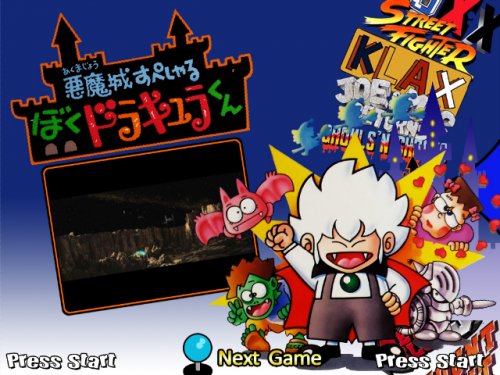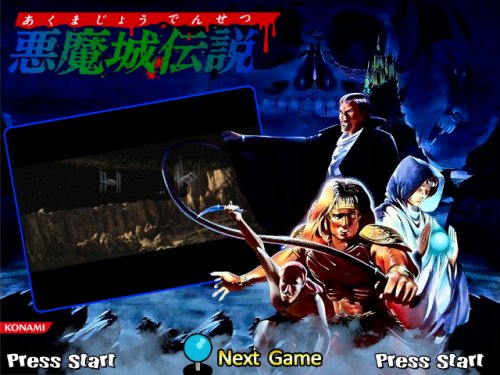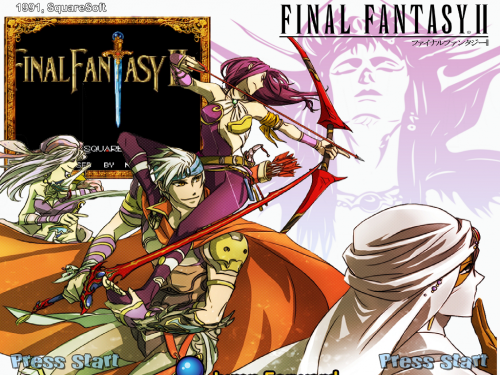FF2 Final Fantasy II theme, what else ?

Akumajou Special - Boku Dracula-kun (Japan) (Translated En)
Akumajō Special: Boku Dracula-kun (悪魔城すぺしゃる ぼくドラキュラくん Akumajō Supesharu: Boku Dorakyura-kun?, lit. "Demon Castle Special: I'm Kid Dracula") is a platformer video game made by Konami. It was released only in Japan for the Famicom on 19 October 1990.[1] The game was never localized outside Japan until a fan created translation was released in 2003. It is considered a parody of the Castlevania series. A version for mobile phones was also released on 30 June 2006 in Japan only.
Easter Egg
At the title screen, entering the Konami Code (Up, Up, Down, Down, Left, Right, Left, Right, B, A) will give a tone for correct code entry. Pressing Start, however, gives you nothing more than a mocking message.
Japanese
English
ざんねんでした。 なにもないよ~ん!
Too bad. There's nothing here!
The program code were intended to have more than one cheat codes at once, but there is only one cheat entry left in the pointer table for the cheats, the rest is removed at some point. However, some coding for at least one more additional cheat flag exist in the game. Code PAVLSYAA will replace the easter cheat effect with the scrapped unused one, which will gives to you extra 50 lives instead at the start of the new game.

Nintendo Famicom - Akumajou Densetsu (Japan)-klopjero
Castlevania III: Dracula's Curse, known in Japan as Akumajō Densetsu (悪魔城伝説?, literally Devil's Castle Legend),[2] is the third and final Castlevania video game produced for the Nintendo Entertainment System. It was published by Konami in Japan in 1989, in North America in 1990, and in Europe in 1992 (some time after the European release of Super Castlevania IV). It was later released on the Wii Virtual Console in the PAL regions on October 31, 2008, in North America on January 12, 2009 and in Japan on April 21, 2009.
The plot of Castlevania III: Dracula's Curse is a prequel to the original Castlevania (much like the earlier Game Boy game Castlevania: The Adventure) set a few centuries before the events of the original game. The game's protagonist is Trevor C. Belmont, an ancestor of the original hero Simon Belmont.
Regional Differences
Castlevania III managed to slip a lot of religious imagery under Nintendo's radar, but all of the game's nudity has been censored. Some graphics and palettes have also been improved.
Akumajou Densetsu
Castlevania III
The nude statues seen on the name entry screen and password screen have been given dresses and their shading has been updated. The vines that were originally on the statues were removed. Castlevania III also uses a much more stylish font than Akumajou Densetsu. Amusingly, the opposite went on to happen in Castlevania IV.
Akumajou Densetsu
Castlevania III
The same also applies to the nude statues at Block 8-01 in Dracula's Curse.
Akumajou Densetsu
Castlevania III
The cross in the intro scene originally had a "glowing" effect surrounding it, which was removed in Castlevania III.
Akumajou Densetsu
Castlevania III
Medusa lost her female characteristics in Dracula's Curse.
Akumajou Densetsu
Castlevania III
Besides the breast reduction, the completely messed up animation frame for her aiming upward stance was cleaned up. Still, three of her animation frames were less than perfect. Her head looks suspiciously mispositioned in one of her aiming straight ahead frames.
A few Medusa-tiles went unused in the Japanese ROM, an arm meant for the glitchy animation frame. And a different part of the body found in both ROMs, meant for this frame:
Takahashi Meijin no Bouken-jima (Japan)
Nintendo Famicom




.thumb.jpg.e97815b0be12c15c78d42944ad43f5ef.jpg)